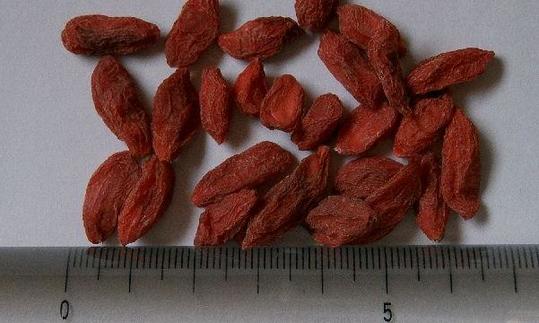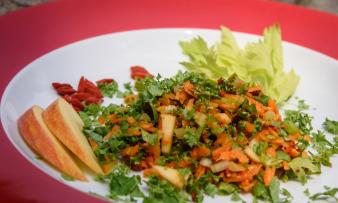Table of contents
The dried goji berries ( Lycium barbarum), also called Chinese wolfberries or Fructus lycii, have been known as a nutrient-rich berry in traditional Chinese cuisine for centuries.
Use in the kitchen
Dried goji berries are one to two centimeters in size, oblong and red. They taste similar to raisins or cranberries, because depending on the growing area they have a sweet to sour, sometimes even bitter taste.
They are an ideal topping for muesli (see, for example, Erb-Müesli) and porridge. They also taste great on salads, for example onlettuce with avocado. You can also use wolfberries in baking and use them in cakes, biscuits or bread.
In China, wolfberry berries are used as a topping for soups, rice congee and hot dishes. They are also added to freshly prepared chrysanthemum tea. The berries are also used in Chinese natural medicine.
Vegan recipe for goji chia pudding
Ingredients (for 4 people): 60 g dried goji berries (soaked in water overnight), 300 ml oat milk (or other plant-based drink), 2 tbsp maple syrup or agave syrup, 1/2 tspvanilla powder, 1/2 tsp ginger powder, 4 tbsp chia seeds, 2 oranges.
Preparation: Drain the goji berries that have been soaked overnight, puree them in a blender with plant-based drink, maple or agave syrup, vanilla and ginger powder. Stir in the chia seeds. Pour the mixture into glasses and leave covered for at least 2 hours. Peel and fillet the oranges. Garnish the goji-chia pudding with orange fillets, and sprinkle a few more goji on top if necessary.
Vegan recipes with dried goji berries can be found under the note: " Recipes that have the most of this ingredient ".
| Not only vegans or vegetarians should read this: Vegans often eat unhealthily. Avoidable nutritional errors. |
Found in the wild:
Common boxthorn is a neophyte in Europe as an ornamental and cultivated plant, ie it was introduced by humans, but has since become established and occasionally occurs in the wild. 8,9
Purchasing - Storage
Dried goji berries can be found in the range of large supermarket chains such as Coop, Migros, Denner, Volg, Spar, Aldi, Lidl, Billa, Rewe, Edeka or Hofer. Dried wolfberries can also occasionally be bought in organic supermarkets such as Denn's Biomarkt or Alnatura. The fresh goji berries are harvested in open-air cultivation from August to November. 4
The term "raw food" is not protected by law - unlike organic. You have to be careful when using the term "raw" or sun-dried, as retailers do not always take the temperature restrictions (e.g. 42 or 45 °C for "real" raw food) seriously. Conscious consumers should prefer non-sulphured dried wolfberries (unsweetened). Treatment with sulphur increases the shelf life and ensures that the colour of the dried fruit is retained (good appearance). Sulphurization is not necessary, however, as non-sulphured dried fruit also lasts for several months. We recommend eating products that are as close to natural and untreated as possible.
The availability of dried goji berries in the supermarkets mentioned varies depending on the size of the store, catchment area, etc. If you are interested, click on our recorded food prices for the DA-CH countries (above under the ingredient image). There you will find current prices from various supermarkets and their price development.
Storage tips
Dried fruit such as dried goji berries can be stored in airtight containers for about a year if kept dry, cool and protected from light. 3
Ingredients - Nutritional values - Calories
Dried wolfberries contain 349 kcal per 100 g. The protein content is medium at 14 g/100g and the fat content is low at 2.4 g/100g. You get 77 g/100g of carbohydrates, of which 46 g is sugar. The salt content is also very high at 757 mg/100 g (corresponds to 31.5% of the recommended daily salt intake). 2
Wolfberries contain a lot of vitamin A, with 1341 µg/100g, as RAE. This corresponds to 168% of the daily requirement. 2 Chili powder (1483 µg/100g) and moringa powder (1675 µg/100g) have comparable values. Small sorrel (1250 µg/100g), pasteurized carrot juice (956 µg/100g) and carrots (835 µg/100g) have high vitamin A values. 1
It also contains vitamin E. 100 g of dried goji contains 8.0 mg, which covers 67% of the daily requirement. 2 This is quite a lot for a dried fruit, compared to dried apricot (4.3 g/100g) and dried mango (4.4 g/100g). Nuts in particular contain vitamin E, for example peanuts (8.3 g/100g) and pine nuts (9.3 g/100g). Almonds (25.6 mg/100g) and sunflower seeds (35 mg/100g) have higher values. 1
100 g of wolfberries contain 48 mg of vitamin C, which is 61% of the daily requirement. 2 This is comparable to clementines (49 mg/100g), oranges and lemons (both 53 g/100g). Sea buckthorn berries contain a lot of vitamin C at 450 mg/100g. 1
Do goji berries contain a lot of iron? You often read that wolfberries are supposed to contain a lot of iron. The iron content is actually higher at 8 mg/100 g (equivalent to 49% of the daily requirement). For example, 100 g of raw spinach contains only 2.7 mg of iron. However, there are some foods that contain significantly more iron, including raw morels (12 mg), white beans (10 mg), dried tomatoes (9.1 mg) and dried porcini mushrooms (8.4 mg). 1
The complete ingredients of dried goji berries, the coverage of the daily requirement and comparison values with other ingredients can be found in our nutrient tables. In the article Nutrients explained you will get a detailed insight into the topic.
Health effects
Dried goji berries are sometimes referred to as a "superfood". They are said to be rich in vitamin A, vitamin C and iron. This is correct (see nutritional tables under the ingredients image), but there are some foods that contain even more of these nutrients (see explanations under ingredients - nutritional values - calories).
In Asia, wolfberries are known for their positive effect on the eyes (see folk medicine - natural medicine). They actually contain large amounts of the carotenoids zeaxanthin and lutein, which can prevent eye diseases such as macular degeneration. 20
The bioavailability of carotenoids depends on factors influencing the food and how it is prepared and processed. The factors influencing the food itself are the subject of current research and cannot be influenced by the consumer. 21 On the other hand, the careful preparation of a food can noticeably increase the intake of carotenoids. Factors such as adding fat, chopping or cooking increase their accessibility and thus their absorption. 24 Chopping plays the biggest role here. 21,24
Although fat increases carotenoid absorption in any case, it is much more efficient to chop the food up (chew well, puree, etc.). Natural fats such as nuts ( macadamia, walnuts, etc.) or avocado are sufficient for fat intake. 21,23 You should avoid additional oily additives or butter, as they do not achieve better results in terms of bioavailability and do more harm than good. Cooking helps to destabilize the cell walls and thus also contributes to availability, but at the same time destroys heat-sensitive ingredients such as many B vitamins or vitamin C. 21,22
Dangers - Intolerances - Side effects
Consuming goji berries together with blood-thinning medication is dangerous, as these can increase the anticoagulant effect. 10 Drug interactions with vitamin K antagonists ("Warfar...", "Phenpro..." etc.) can occur. 11
Wolfberries have a high allergy potential and show cross-allergies with peach, tomato, tobacco, nuts or ragweed. 12 Allergic reactions are also possible in people who have never eaten wolfberries before. 13
Pesticide residues have been repeatedly found in dried wolfberry berries, even in 'organic' berries. 5,6 Therefore, those with the European organic label are preferable.
Folk medicine - natural medicine
In traditional Chinese medicine ( TCM), goji berries are considered to have a yin tonic effect. They are said to nourish the liver and kidneys and strengthen the eyes. 7 In China, Fructus lycii is traditionally used for blurred vision, fever, night sweats, kidney weakness, coughs and asthma, diabetes, heart disease, "weak nerves" and gynecological problems. 17
Ecological footprint - animal welfare
Despite the occasional cultivation of goji berries in countries such as the USA, Brazil, Italy or Poland, the majority of cultivation still takes place in China. 26 For consumers in Europe, this means long transport routes and correspondingly high emissions. In order to keep the ecological footprint as low as possible, it is best to buy dried goji berries from European production. Individual projects, for example in Portugal, are also committed to more environmentally friendly cultivation of boxthorn, e.g. by using solar energy to dry the berries and reintroducing organic material into production. 27
Due to their high sugar content, goji berries are very susceptible to pests such as mites and aphids, whose infestation can reduce the harvest by up to 25%. To regulate this, pesticides are increasingly being used in China. However, only a small number of pesticides are officially approved for goji berries, which often leads to the use of unlicensed insecticides and fungicides. 28 Up to 13 different pesticides have been proven to be found on goji berries. 29 Although the values in a random sample test were below the maximum residue levels 26, the purchase and consumption of conventionally grown goji berries is nevertheless not advisable. The use of synthetic pesticides and fertilizers is prohibited in organic farming, so these products are to be preferred to conventionally grown goji berries.
Worldwide occurrence - cultivation
The common boxthorn ( Lycium barbarum L.) and the Chinese boxthorn ( Lycium chinense Mill.) originally come from China. 14 The boxthorn was introduced as a cultivated plant in many parts of Asia (including Tibet, Korea), as well as in Europe, North America, Australia and New Zealand. 15,16,17
Commercial cultivation has so far taken place almost exclusively in China, which is why China is the largest producer of wolfberries. 18 However, there are also smaller and larger cultivation areas in Europe (including Portugal 18, Spain 19), the USA and Canada, as well as in Australia and New Zealand. 15,16
Found in the wild
Common boxthorn is a neophyte in Europe as an ornamental and cultivated plant, ie it was introduced by humans, but has since become established and occasionally occurs in the wild. 8,9
Cultivation - Harvest
The common boxthorn can be easily grown in the garden or as a pot plant. You can find out more about this under the ingredient fresh goji berries.
Industrial production
After harvesting, the berries are dried, with industrially produced goods usually being dried using hot air or freeze drying. 25 The berries are often also 'sulphurised' to extend their shelf life. Sun-dried organic berries are also sometimes produced in raw food quality. Here, you should make sure that the retailer maintains the temperatures required for raw food (more on this under Purchasing).
Further information
The berries of the common boxthorn ( Lycium barbarum) together with those of the Chinese boxthorn ( Lycium chinense) are known as goji berries. The boxthorn is a plant species within the nightshade family (Solanaceae).
Alternative names
Goji is derived from the Chinese term gǒuqǐ, which means boxthorn. The berries are also known as Chinese wolfberry or Fructus lycii or wolfberry.
Bibliography - 28 Sources
| 1. | USDA United States Department of Agriculture. |
| 2. | Niro S, Fratianni A, Panfili G, Falasca L, Cinquanta L, Alam MR. Nutritional evaluation of fresh and dried goji berries cultivated in italy. Italian Journal of Food Science. 2017 Feb;29(3): 398-408. |
| 3. | Bundeszentrum für Ernährung. Lebensmittellagerung im Haushalt (pdf). |
| 4. | Gartenjournal.net. Goji Beeren aus eigenem Anbau ernten. |
| 5. | CVUA Stuttgart. Pestizide in Gojibeeren 2010. |
| 6. | Czech Agriculture and Food Inspection Autority. More than 2 tons dry goji berries from China contained forbidden pesticides Carbofurans. 2017. |
| 7. | Therapeutika.ch. Gou Qi Zi. |
| 8. | Infoflora.ch. Lycium barbarum L. |
| 9. | Floraweb.de. Lycium barbarum L. |
| 11. | PharmaWiki.ch. Goji. |
| 12. | Carnés J, de Larramendi CH, Ferrer A, Huertas AJ, López-Matas MA, Pagán JA, Navarro LA, García-Abujeta JL, Vicario S, Peña M. Recently introduced foods as new allergenic sources: sensitisation to Goji berries (Lycium barbarum). Food Chem. 2013 Apr 15;137(1-4): 130-5. |
| 13. | Larramendi CH, García-Abujeta JL, Vicario S, García-Endrino A, López-Matas MA, García-Sedeño MD, Carnés J. Goji berries (Lycium barbarum): risk of allergic reactions in individuals with food allergy. J Investig Allergol Clin Immunol. 2012;22(5): 345-50. |
| 14. | USDA, Agricultural Research Service, National Plant Germplasm System. 2022. Germplasm Resources Information Network (GRIN Taxonomy). National Germplasm Resources Laboratory, Beltsville, Maryland. |
| 15. | GBIF Backbone Taxonomy. gbif.org. Lycium barbarum L. |
| 16. | GBIF Backbone Taxonomy. gbif.org. Lycium chinense Mill. |
| 17. | Yao R, Heinrich M, Zhao X, Wang Q, Wei J, Xiao P. What's the choice for goji: Lycium barbarum L. or L. chinense Mill.? J Ethnopharmacol. 2021 Aug 10;276: 114185. |
| 18. | EIP-AGRI. Inspirational ideas: European goji berries. |
| 19. | Gojivital.com. Goji-Beere, die Mini-Vitaminbombe. |
| 20. | Neelam K, Dey S, Sim R, Lee J, Au Eong KG. Fructus lycii: A Natural Dietary Supplement for Amelioration of Retinal Diseases. Nutrients. 2021 Jan 16;13(1): 246. |
| 21. | Priyadarshani AM. A review on factors influencing bioaccessibility and bioefficacy of carotenoids. Crit Rev Food Sci Nutr. 2017 May 24;57(8): 1710-1717. |
| 22. | Castenmiller JJ, West CE. Bioavailability and bioconversion of carotenoids. Annu Rev Nutr. 1998;18: 19-38. |
| 23. | Unlu NZ, Bohn T, Clinton SK, Schwartz SJ. Carotenoid absorption from salad and salsa by humans is enhanced by the addition of avocado or avocado oil. J Nutr. 2005 Mar;135(3): 431-6. |
| 24. | Hedrén E, Diaz V, Svanberg U. Estimation of carotenoid accessibility from carrots determined by an in vitro digestion method. Eur J Clin Nutr. 2002 May;56(5):425-30. |
| 25. | FEI Forschungskreis der Ernährungsindustrie e.V. Fruchtige Snacks und natürliche Fruchtaromen: Innovative Produkte dank energieeffizienter und produktschonender Trocknung. 2017. |
| 26. | Zhang Y., et al. Levels and health risk assessments of pesticides and metals in Lycium barbarum L. from different sources in Nigxia, China. Sci Rep. 2022; 12:561 |
| 27. | Goparity. Goji orchard. 2023. |
| 28. | Chen H, Shen S, Zhi H, Li W. Pesticides residues on Goji berry: A characteristic minor crop in China. Journal of Food Composition and Analysis. 2023. |
| 29. | Der Standard. Lokale Alternativen zum weitgereisten "Superfood". 2018. |









Comments